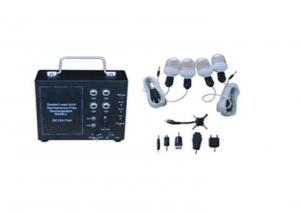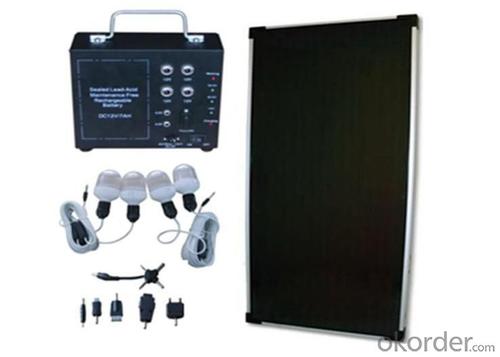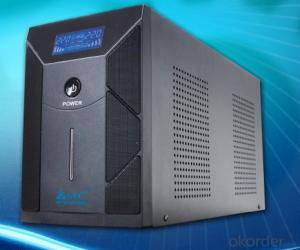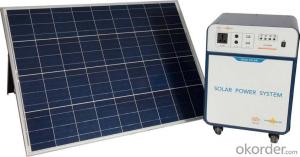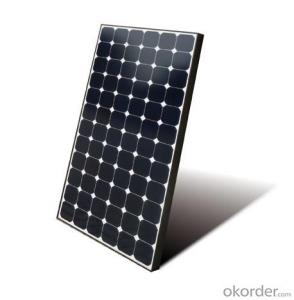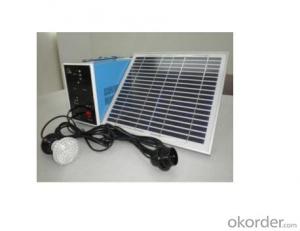Solar Energy Systems Au - CNBM-TS2 (15W)
- Loading Port:
- China Main Port
- Payment Terms:
- TT or L/C
- Min Order Qty:
- 1 set set
- Supply Capability:
- 1000 sets per month set/month
OKorder Service Pledge
OKorder Financial Service
You Might Also Like
Brief Introduction of Solar Energy System CNBM-TS2 (15W)
CNBM Solar is specialized in PV power systems 15W ourput.
Our company not only can supply high quality solar Products, but also provides professional system Solutions and high quality services.
large blocks of molten silicon carefully cooled and solidified. PolySi cells are less expensive to produce than single crystal silicon cells,
but are less efficient.
US DOE data shows that there were a higher number of multicrystalline sales than monocrystalline silicon sales.
The Sketching of Solar Energy System CNBM-TS2 (15W)
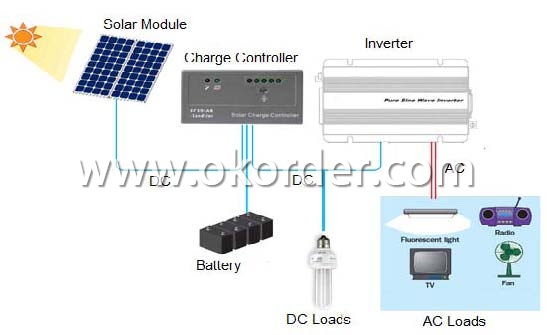
Components of Solar Energy System CNBM-TS2 (15W)
PV Array:
Convert sunlight instantly into DC electric power. Formed by the solar modules (also called photovoltaic modules) in accordance with the system requirements for series and parallel.
Solar Charge Controller:
A charge controller may be used to power DC equipment with solar panels. The charge controller provides a regulated DC output and stores excess energy in a battery as well as monitoring the battery voltage to prevent over charge or over discharge. An inverter can be connected to the output of a charge controller to drive AC loads.
Inverter:
Converts DC output power of photovaltaic soalr panels into standard AC power for use in the local off-grid electrical network. It is a critical component in a photovoltaic system, allowing the use of ordinary commercial appliances.
Battery banks:
Stores energy when there is an excess coming in and distribute it back out when there is a demand. Solar PV panels continue to re-charge batteries each day to maintain battery charge.
Technical data of Solar Home System CNBM-TS2 (15W) | ||||
Solar panel | Pmax | 15W | ||
Vmp | 17.5V | |||
Imp | 0.857A | |||
Battery | Capacity | 12V/7AH | ||
Accessories | 5W Amorphous Solar panel*1 Power box *1 LED bulb with 10m wire*4 Mobile phone adapter*1 Mounting pad*1 | |||
Package Data of Solar Home system CNBM-TS2 (15W) | ||||
Carton Size (L*W*H mm) | Carton Weight(kg) | PCS/CTN | 20’(PCS) | 40’(PCS) |
1215*185*375 | 19.8 | 2 | 600 | 1300 |
Factory Picture of Solar Energy System CNBM-TS2 (15W)
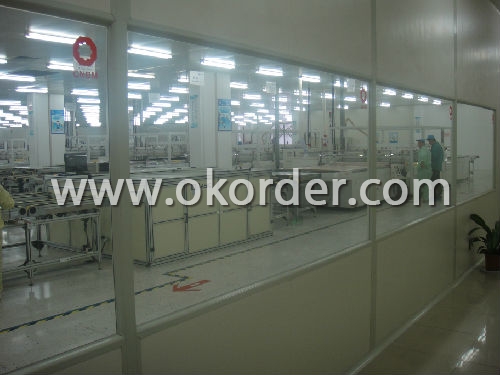
Package Picture2 of Solar Energy System CNBM-TS2 (15W)

- Q: How does the efficiency of solar panels vary based on the angle and orientation?
- The efficiency of solar panels may vary depending on the angle and orientation they are positioned in. The performance of solar panels can be significantly impacted by the tilt angle at which they are set. It is ideal to position solar panels at an angle that allows them to receive maximum sunlight exposure throughout the day. The highest efficiency of solar panels is achieved when they are oriented perpendicular to the sun's rays. This means that solar panels should directly face the sun without any obstruction or shading. When solar panels are properly angled, they can capture the maximum amount of sunlight, resulting in higher energy production. The orientation of solar panels also plays a vital role in their efficiency. In the Northern Hemisphere, solar panels should generally face south to receive the most sunlight. Facing south allows panels to receive sunlight for the longest duration during the day. However, in the Southern Hemisphere, solar panels should face north for optimal efficiency. Improperly angled or oriented solar panels can experience a decrease in efficiency. If panels are tilted too steeply or too shallow, they may not receive the maximum amount of sunlight. Similarly, if solar panels are not facing the correct direction, they may not efficiently capture sunlight. It is important to note that solar panels can still generate electricity even if they are not perfectly angled or oriented. However, their efficiency will be lower, resulting in a lower energy output. Factors such as temperature, dust, and shading from nearby objects or trees can also affect the efficiency of solar panels. To maximize the efficiency of solar panels, it is advisable to seek professional consultation. Experts can assess the specific location and provide guidance on the optimal angle and orientation for the panels. By ensuring that solar panels are correctly angled and oriented, individuals can maximize energy production and enjoy the benefits of solar power.
- Q: Can solar energy systems be installed on parking lots or carports?
- Yes, solar energy systems can be installed on parking lots or carports. In fact, these locations offer ample space for solar panel installations, allowing for the generation of clean and renewable energy while also providing shade for parked vehicles. This dual-purpose use of space is increasingly popular and beneficial in terms of reducing carbon emissions and utilizing underutilized areas for sustainable energy production.
- Q: How does the efficiency of solar panels vary based on the temperature?
- The efficiency of solar panels can vary based on the temperature. Generally, solar panels operate more efficiently in cooler temperatures, while their efficiency decreases as the temperature rises. This is due to the nature of the materials used in solar panels, particularly the semiconductor materials like silicon. When the temperature increases, the electrons in the semiconductor material gain more energy, leading to an increase in the voltage output of the solar panel. However, this increase in voltage does not proportionally increase the power output, resulting in a decrease in the overall efficiency. Additionally, higher temperatures can cause an increase in the resistance of the electrical conductors within the solar panel, leading to power losses and reduced efficiency. This is known as thermal losses. The increased resistance can hinder the flow of electric current, reducing the overall power output. Moreover, high temperatures can also lead to a phenomenon called the "thermal runaway effect," where the increase in temperature causes the solar panel's efficiency to decline rapidly. This can be particularly problematic in areas with hot climates or during heatwaves. To mitigate the negative effects of temperature on solar panel efficiency, some advanced solar panel designs incorporate cooling mechanisms. For example, some panels have built-in ventilation systems or are elevated to allow air to circulate below, helping to dissipate excess heat and maintain optimal operating temperatures. In conclusion, the efficiency of solar panels can vary based on the temperature. While they operate more efficiently in cooler temperatures, their efficiency decreases as the temperature rises due to increased resistance, thermal losses, and the thermal runaway effect. It is important to consider these factors while designing and installing solar panels to maximize their performance and output.
- Q: Can solar energy systems be installed on military bases or installations?
- Yes, solar energy systems can be installed on military bases or installations. In fact, many military bases across the world have already embraced solar power as a clean and sustainable energy source. These installations not only reduce reliance on traditional fossil fuels but also enhance energy security and resilience for critical operations. Additionally, solar energy systems on military bases can contribute to cost savings, environmental stewardship, and serve as an example for the broader community.
- Q: Can a solar energy system be installed on a museum or cultural institution?
- Yes, a solar energy system can be installed on a museum or cultural institution. Solar panels can be mounted on the roof or in an open space surrounding the building to harness sunlight and convert it into electricity. This can help the institution reduce its reliance on conventional energy sources, lower its carbon footprint, and potentially save on electricity costs in the long run. Additionally, the installation of solar panels can also serve as an educational display, highlighting the institution's commitment to sustainability and renewable energy.
- Q: Can solar energy systems be used in areas with limited access to solar energy regulations and policies?
- Yes, solar energy systems can still be used in areas with limited access to solar energy regulations and policies. While regulations and policies can help promote and facilitate the adoption of solar energy, they are not necessarily a prerequisite for the installation and operation of solar panels. As long as there is sufficient sunlight available, solar energy systems can still be utilized effectively in areas without comprehensive regulations and policies in place. In such scenarios, individuals or organizations may need to navigate any existing regulatory frameworks or work towards implementing suitable policies to ensure the smooth functioning and integration of solar energy systems.
- Q: Can solar energy systems be used for emergency power backup?
- Yes, solar energy systems can be used for emergency power backup. Solar panels can generate electricity during the day, even when the grid is down, and this energy can be stored in batteries to provide power during emergencies or blackouts. This allows for a reliable and sustainable source of backup power, reducing reliance on traditional generators and fossil fuels.
- Q: How much does it cost to install a solar energy system?
- The cost of installing a solar energy system can vary depending on various factors such as the size of the system, location, equipment used, and installation costs. On average, residential solar energy systems can range from $15,000 to $25,000 after accounting for tax incentives and rebates. However, it is recommended to obtain personalized quotes from solar installation companies to get an accurate estimate for your specific needs.
- Q: Can solar energy systems be used in powering amusement parks?
- Yes, solar energy systems can be used to power amusement parks. Solar panels can be installed on the roofs of buildings, parking structures, or in open spaces within the park to generate electricity from the sun. This renewable energy source can help reduce the park's reliance on traditional grid power, lower operating costs, and decrease its carbon footprint. Additionally, solar energy systems can provide a reliable and consistent source of power, making them suitable for meeting the electrical demands of amusement parks.
- Q: How do solar energy systems impact the transportation sector?
- Solar energy systems impact the transportation sector by providing a renewable source of power for electric vehicles (EVs) and public transportation. Solar-powered charging stations and infrastructure reduce the dependence on fossil fuels, decrease greenhouse gas emissions, and promote sustainable transportation options. Additionally, solar energy can also be used to power auxiliary systems in vehicles, making them more energy-efficient and reducing their carbon footprint.
Send your message to us
Solar Energy Systems Au - CNBM-TS2 (15W)
- Loading Port:
- China Main Port
- Payment Terms:
- TT or L/C
- Min Order Qty:
- 1 set set
- Supply Capability:
- 1000 sets per month set/month
OKorder Service Pledge
OKorder Financial Service
Similar products
Hot products
Hot Searches
Related keywords

